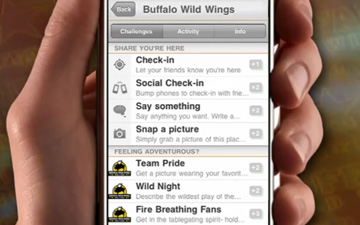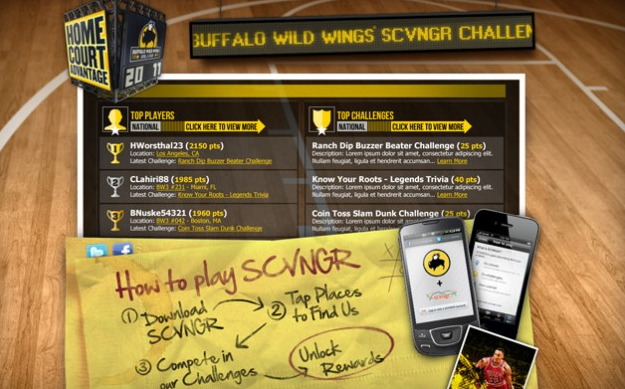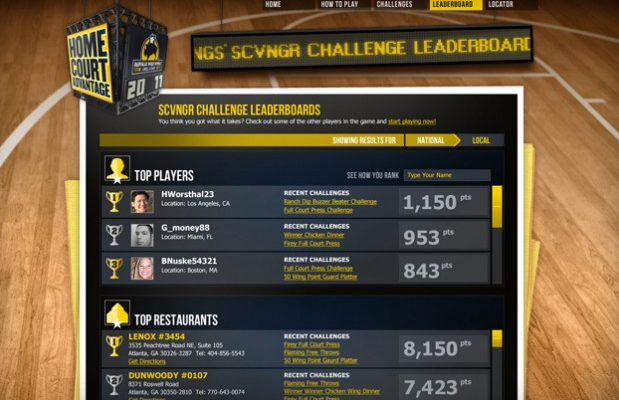You are viewing our site as an Agent, Switch Your View:
Agent | Broker Reset Filters to Default Back to ListHow SCVNGR’s First National Brand Partnership Scored Big During March Madness
June 01 2011

The Behind the Social Media Campaign Series is supported by Oneupweb, an award-winning agency specializing in search marketing, social media and design for mid-to-enterprise level brands. Download Oneupweb's free whitepaper, "The Bloody Truth about Social Media."
 SCVNGR is a location-based gaming platform – there are challenges at every venue, and businesses can also "script" their own challenges. Customers can do challenges (take a photo, eat a certain dish) to earn points, which are redeemable for real-world rewards, such as a free drink or 10% off. The Cambridge-based company launched in 2008, and was founded by a 22-year old Princeton dropout who wanted to add a game layer to the world. And that he did.
SCVNGR is a location-based gaming platform – there are challenges at every venue, and businesses can also "script" their own challenges. Customers can do challenges (take a photo, eat a certain dish) to earn points, which are redeemable for real-world rewards, such as a free drink or 10% off. The Cambridge-based company launched in 2008, and was founded by a 22-year old Princeton dropout who wanted to add a game layer to the world. And that he did.
In January 2011, SCVNGR partnered with Buffalo Wild Wings (BWW) — at all 730 of its locations — for a 12-week campaign leading up to March Madness. The competitive game layer of SCVNGR worked well with the BWW patrons, who thrive on competition, community and games. SCVNGR's SVP of Marketing Chris Mahl says that what differentiates SCVNGR from other location-based services is that it's "not a checkin-based service, [but something] that goes further into brand goals [and] consumer goals." The success of the campaign indicates that that may be true. BWW was the first national SCVNGR promotion, and in the first three weeks, the game accrued nearly 30,000 players. By the end, the campaign had 184,000 players at 730 BWW locations.
The Concept

Interactive agency BFG drove the campaign and helped spread awareness of it via several avenues. BWW had several goals, including generating earned media and consumer engagement, improving customer return rates and, of course, driving revenue. By turning the act of watching games into a game in and of itself, these brand goals were accomplished in a fun, meaningful way.
Mahl attributes the success of the BWW promotion to a few things that created a sort of perfect storm for the campaign:
- Good timing. It revolved around March Madness, when there is a heightened interest in sports and school spirit, even for those who might otherwise not be interested.
- Excellent staff training. BWW staff played around with SCVNGR for a week before it launched to consumers, so they were invested and well-versed in the game once it launched. They could answer any questions about the app and encourage people to get in the game.
- Prominent marketing. The BWW campaign was well promoted via Facebook, Twitter, a tab on the BWW Facebook Page, web embeds on the BWW website, in-store television spots, menu inserts, table tents and SCVNGR window clings.
These guerilla marketing tactics made it so that when you walked in the door at BWW, there was no way you didn't know what was happening. Plus, the March Madness-obsessed fans are a captive audience, and they were targeted in a comfortable, laid-back environment where they were already hanging out and drinking with friends, so it didn't take much to get them involved.
The Campaign

BWW set up three custom challenges and offered restaurant rewards for those who completed. Rewards for completed challenges included $5 off (3 points), a free Coca-Cola (20 points) and free wings (30 points). Serving staff, having been trained with the app, were prepared to redeem rewards immediately, so the challenges and redemptions were happening in real time. If someone was hungry and wanted more wings, they could figure out a challenge that would earn them such wings and be much more fun than shelling over some green.
BWW's challenges asked people to take pictures of their friends, the sauciest wing in the basket, fans of rival teams and the crowd going wild, to name a few. These photos were shared on the SCVNGR network, and many chose to share them on Facebook and Twitter, too.

The custom challenges allowed people to go from being players and participant to becoming "authors" — they weren't just playing SCVNGR, they were "engaging with us" and creating their own adventures, Mahl says. SCVNGR gave them ownership to do what they wanted in order to earn points to unlock badges and rewards. Further, one could find the reward he or she wanted and figure out exactly what challenges needed to be done to get it. This kept people engaged in the game and the app, and spurred people to bring friends into the game, too.
Once a player completed the custom challenges scripted by BWW, he became a sort of power user who could create his own challenges. The user-generated challenges that were most popular floated to the top of the list, acting as a sort of crowdsourced filter. As with any crowdsourcing, there's a risk of inappropriate or bizarre material, and though many of the BWW patrons are what Mahl describes as "edgy, passionate and strong personalities," the user-generated challenges went slightly awry. But SCVNGR acted quickly and built a curation system to "keep it clean" and sift through the challenges twice a day to pull out any subpar challenges.
The campaign went well beyond the walls of each BWW location, too. A web-based leaderboard showed the point total for users on a national scale, spurring even more competition amongst players vying for the grand prize — a trip to the NBA finals with former Chicago Bulls player and Hall of Famer Scottie Pippen.

The Results
Here are some statistics from the three-month campaign:
- Players generated 20,000+ challenges, 15,000 of which were approved (remember the curation filter?).
- There were 184,000 unique players at 730 nationwide BWW locations.
- 1 in 3 players returned to play again.
- On average, users completed 7 challenges, meaning they did all the ones provided by BWW and a few user-generated ones.
- The campaign generated more than 100 million social impressions via Facebook and Twitter.
- On average, a player spent 90 seconds per challenge, meaning that BWW saw the equivalent of 3.6 years of brand engagement in its locations during the campaign.
"This kind of engagement just doesn't exist," says Mahl, referring to the stats from the BWW campaign. He adds that the campaign went off without a hitch — people were badged, recognized and unlocked their rewards. "Everything worked," he says.
To boot, the successful campaign came at a "surprisingly low cost" to BWW, though Mahl would not disclose the exact figure. So what made it click?
"[The] BWW [campaign] was well-advertised," says Mahl. "Sometimes you just don't know there's a game. BWW understood that and took the time to properly promote it and invited employees to play first." Further, BWW is what Mahl calls a "socially progressive, community-based place," which lends itself to the SCVNGR model. People come ready to play, with their game faces on.
Three months have passed, and BWW is refreshing its campaign as the "Flavor Fanatic Challenge." Since BWW already has a player database of 184,000 people, BWW used the in-app invitation to get the March Madness players back in the game and back in their seats at BWW.









